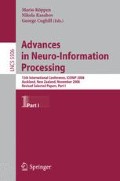Abstract
An information geometrical method is developed for characterizing or classifying neurons in cortical areas, whose spike rates fluctuate in time. When the interspike intervals of a spike sequence of a neuron obey a gamma process with a time-variant spike rate and a fixed shape parameter, the information geometry for semiparametric estimation has given the optimal method from the statistical viewpoint. Recently a more suitable statistical model for interspike intervals is proposed, which have an absolute refractory period. This work extends the information geometrical method and derives the optimal method for the new model.
Access this chapter
Tax calculation will be finalised at checkout
Purchases are for personal use only
Preview
Unable to display preview. Download preview PDF.
References
Holt, G.R., Softky, W.R., Koch, C., Douglas, R.J.: Comparison of discharge variability in vitro and in vivo in cat visual cortex neurons. Journal of Neurophysiology 75, 1806–1814 (1996)
Shinomoto, S., Sakai, Y., Funahashi, S.: The ornstein-uhlenbeck process does not reproduce spiking statistics of neurons in prefrontal cortex. Neural Computation 11, 935–951 (1999)
Sakai, Y., Funahashi, S., Shinomoto, S.: Temporally correlated inputs to leaky integrate-and-fire models can reproduce spiking statistics of cortical neurons. Neural Networks 12, 1181–1190 (1999)
Shinomoto, S., Shima, K., Tanji, J.: New classification scheme of cortical sites with the neuronal spiking characteristics. Neural Networks 15(10), 1165–1169 (2002)
Shinomoto, S., Shima, K., Tanji, J.: Differences in spiking patterns among cortical neurons. Neural Computation 15(12), 2823–2842 (2003)
Tiesinga, P.H.E., Fellous, J.M., Sejnowski, T.J.: Attractor reliability reveals deterministic structure in neuronal spike trains. Neural Computation 14, 1629–1650 (2002)
Amari, S.I.: Differential-Geometrical Methods in Statistics. Lecture Notes in Statistics, vol. 28. Springer, Heidelberg (1985)
Amari, S.I., Nagaoka, H.: Methods of Information Geometry. Translations of Mathematical Monographs, vol. 191. AMS and Oxford Univ. Press, Oxford (2000)
Miura, K., Shinomoto, S., Okada, M.: Search for optimal measure to discriminate random and regular spike trains. Technical Report NC2004-52, IEICE (2004)
Ikeda, K.: Information geometry of interspike intervals in spiking neurons. Neural Computation 17(12), 2719–2735 (2005)
Miura, K., Okada, M., Amari, S.I.: Estimating spiking irregularities under changing environments. Neural Computation 18(10), 2359–2386 (2006)
Shinomoto, S.: Private communication
Shinomoto, S., Tsubo, Y.: Modeling spiking behavior of neurons with time-dependent poisson processes. Physical Review E 64, 41910 (2001)
Godambe, V.P.: Conditional likelihood and unconditional optimum estimating equations. Biometrika 63, 277–284 (1976)
Godambe, V.P. (ed.): Estimating Functions. Oxford Univ. Press, Oxford (1991)
Amari, S.I., Kawanabe, M.: Information geometry of estimating functions in semiparametric statistical models. Bernoulli 2(3) (1996)
Author information
Authors and Affiliations
Editor information
Editors and Affiliations
Rights and permissions
Copyright information
© 2009 Springer-Verlag Berlin Heidelberg
About this paper
Cite this paper
Komazawa, D., Ikeda, K., Funaya, H. (2009). Information Geometry of Interspike Intervals in Spiking Neurons with Refractories. In: Köppen, M., Kasabov, N., Coghill, G. (eds) Advances in Neuro-Information Processing. ICONIP 2008. Lecture Notes in Computer Science, vol 5506. Springer, Berlin, Heidelberg. https://doi.org/10.1007/978-3-642-02490-0_89
Download citation
DOI: https://doi.org/10.1007/978-3-642-02490-0_89
Publisher Name: Springer, Berlin, Heidelberg
Print ISBN: 978-3-642-02489-4
Online ISBN: 978-3-642-02490-0
eBook Packages: Computer ScienceComputer Science (R0)

